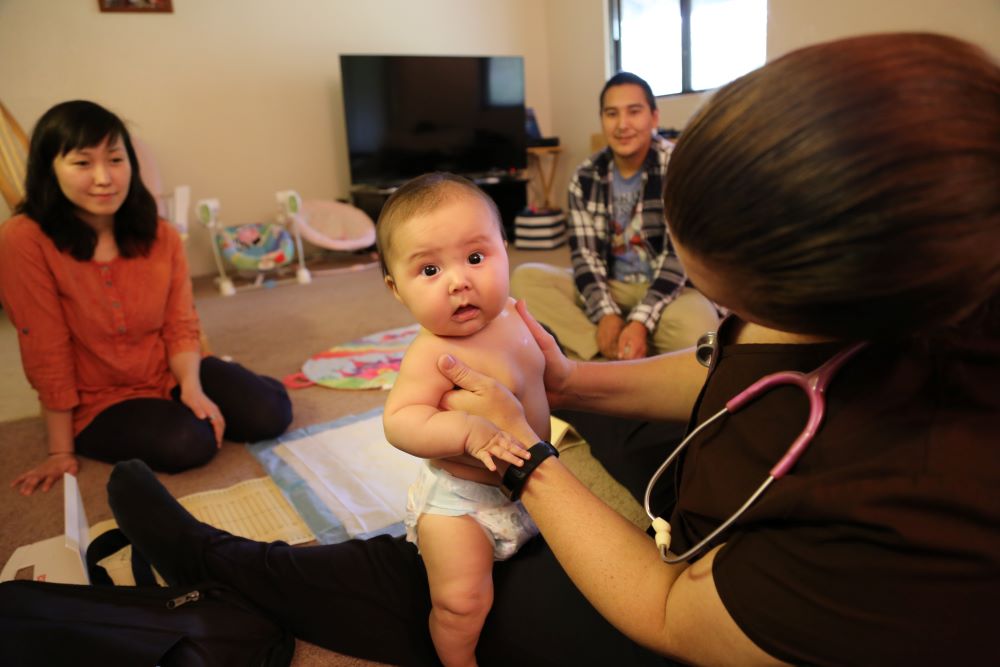 Most babies born in the U.S. get screenings and exams before the hospital discharges them. Usually, a health care provider discusses the results of these tests in their first visits. HSPPS 45 CFR §1302.80 says that within two weeks after the infant’s birth, a program must schedule the newborn visit to offer support and identify family needs. Early Head Start programs can help families understand and follow up on the results from early screenings and exams.
Most babies born in the U.S. get screenings and exams before the hospital discharges them. Usually, a health care provider discusses the results of these tests in their first visits. HSPPS 45 CFR §1302.80 says that within two weeks after the infant’s birth, a program must schedule the newborn visit to offer support and identify family needs. Early Head Start programs can help families understand and follow up on the results from early screenings and exams.
One of these early tests is the newborn hearing screening. The hospital screens almost all newborns before discharging them, and an evaluation is needed for newborns who do not pass the screening. If the family or child’s medical records do not have the results, health managers can contact their state or territorial Early Hearing Detection and Intervention (EHDI) coordinator to schedule a screening.
Compared to older children, infants and toddlers are more vulnerable to infections and have more recommended well-child visits. Most periodicity schedules list 10 or 11 exams by the time a child turns 2. Depending on the age, the child may have well-child visits recommended every few months or even weeks.
The CDC recommends nearly 30 doses of vaccines in a child’s first two years of life. The infant’s immune system improves with each vaccine. Many of these vaccines are a series given over months and years. Some such as varicella (chicken pox) are given once. Others such as influenza (flu) are needed annually, starting at 6 months old. Each immunization protects infants and toddlers better from vaccine-preventable diseases.
Some physical conditions are common during the first few weeks after birth, which is why it is critical that there be regular communication between the program, family, and the child’s health care provider. Common health problems in babies include colds, coughs, fevers, and vomiting. Babies also often have skin problems, like diaper rash or cradle cap. Many of these problems are not serious.
Respiratory syncytial virus (RSV) is a virus that causes symptoms such as trouble breathing. It’s the most common cause of inflammation of the small airways in the lungs (bronchiolitis) and pneumonia in babies. There currently is no vaccine against RSV.
Lead can be found throughout a child’s environment. Because infants and toddlers put so many non-edible items that may contain traces of lead in their mouths, blood lead levels are screened at 12 months and 24 months. There are no safe levels of lead in a child’s blood. If a screening finds lead, health managers can work with the family, child’s health care provider, and public health programs to address health and environmental factors.
Tips and Strategies Related to Physical Health for Infants and Toddlers
- Help families find a pediatric health care provider and health insurance if needed.
- Meet with expectant families to discuss health issues (e.g., sleeping, feeding, or exposure to secondhand smoke) before the baby is born.
- Encourage staff to plan the newborn visit with a family when the birthing person is pregnant.
- Help families understand that regular checkups are an important way to keep track of their child’s health and physical, emotional, and social development and to learn about the best ways to help their child grow.
- Offer education and support to help families keep up to date on exams, screenings, and vaccines in the first three years of life.
- Remind families that your program can help if they have new or recurring health concerns.
- Review each well-child exam to see if there is any action needed for more diagnostic testing, evaluation, treatment, or follow-up.
Learn More
Read more:
Resource Type: Article
National Centers: Health, Behavioral Health, and Safety
Audience: Directors and Managers
Last Updated: September 22, 2023